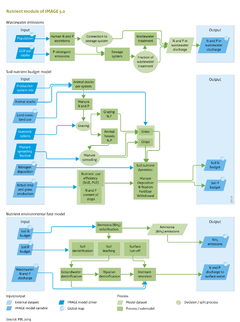Nutrients/Description: Difference between revisions
Jump to navigation
Jump to search
Oostenrijr (talk | contribs) m (Text replace - "NH3" to "NH<sub>3</sub>") |
Oostenrijr (talk | contribs) No edit summary |
||
| Line 1: | Line 1: | ||
{{ComponentDescriptionTemplate | {{ComponentDescriptionTemplate | ||
|Reference=Bouwman et al., 2013c; Van Drecht et al., 2009; Cleveland et al., 1999; Salvagiotti et al., 2008; Beusen et al., submitted; | |Reference=Bouwman et al., 2013c; Van Drecht et al., 2009; Cleveland et al., 1999; Salvagiotti et al., 2008; Beusen et al., submitted; | ||
|Description====Wastewater=== | |Description====Wastewater=== | ||
Urban wastewater contains N and P emitted by households and industries that are connected to a sewerage system, and households with sanitation but without a sewerage connection. | Urban wastewater contains N and P emitted by households and industries that are connected to a sewerage system, and households with sanitation but without a sewerage connection. | ||
N discharges to surface water (''E<sub>sw</sub><sup>N</sup>'' in kg per person per year) are calculated as follows ([[Van Drecht et al., 2009]]; [[Morée et al., 2013]]):{{FormulaAndTableTemplate| | N discharges to surface water (''E<sub>sw</sub><sup>N</sup>'' in kg per person per year) are calculated as follows ([[Van Drecht et al., 2009]]; [[Morée et al., 2013]]):{{FormulaAndTableTemplate|Formula1 Nutrients}}where: | ||
*''E<sub>hum</sub><sup>N</sup>'' is human N emissions (kg per person per year), | *''E<sub>hum</sub><sup>N</sup>'' is human N emissions (kg per person per year), | ||
* D is the proportion of the total population connected to public sewerage systems (no dimension), | * D is the proportion of the total population connected to public sewerage systems (no dimension), | ||
| Line 14: | Line 14: | ||
The soil budget approach ([[Bouwman et al., 2009]]; [[Bouwman et al., 2013c]]) considers all N and P inputs and outputs for IMAGE grid cells. N input terms in the budgets include application of synthetic N fertiliser (N<sub>fert</sub>) and animal manure (N<sub>man</sub>), biological N fixation (N<sub>fix</sub>), and atmospheric N deposition (N<sub>dep</sub>). Output terms include N withdrawal from the field through crop harvesting, hay and grass cutting, and grass consumed by grazing animals (N<sub>withdr</sub>). | The soil budget approach ([[Bouwman et al., 2009]]; [[Bouwman et al., 2013c]]) considers all N and P inputs and outputs for IMAGE grid cells. N input terms in the budgets include application of synthetic N fertiliser (N<sub>fert</sub>) and animal manure (N<sub>man</sub>), biological N fixation (N<sub>fix</sub>), and atmospheric N deposition (N<sub>dep</sub>). Output terms include N withdrawal from the field through crop harvesting, hay and grass cutting, and grass consumed by grazing animals (N<sub>withdr</sub>). | ||
The soil N budget (N<sub>budget</sub>) is calculated as follows:{{FormulaAndTableTemplate| | The soil N budget (N<sub>budget</sub>) is calculated as follows:{{FormulaAndTableTemplate|Formula2 Nutrients}} | ||
The same approach is used for P, with input terms being animal manure and fertiliser. The soil nutrient budget does not include nutrient accumulation in soil organic matter for a positive budget (surplus), or nutrient depletion due to soil organic matter decomposition and mineralisation. With no accumulation, a surplus represents a potential loss to the environment. For N this includes NH<sub>3</sub> volatilisation (see Component [[Emissions]]), denitrification, surface runoff and leaching. For P, this is surface runoff. | The same approach is used for P, with input terms being animal manure and fertiliser. The soil nutrient budget does not include nutrient accumulation in soil organic matter for a positive budget (surplus), or nutrient depletion due to soil organic matter decomposition and mineralisation. With no accumulation, a surplus represents a potential loss to the environment. For N this includes NH<sub>3</sub> volatilisation (see Component [[Emissions]]), denitrification, surface runoff and leaching. For P, this is surface runoff. | ||
Revision as of 15:02, 1 July 2014
Parts of Nutrients/Description
| Component is implemented in: |
| Components: |
| Related IMAGE components |
| Projects/Applications |
| Key publications |
| References |
